Read Reviews
The Best Belt Sanders
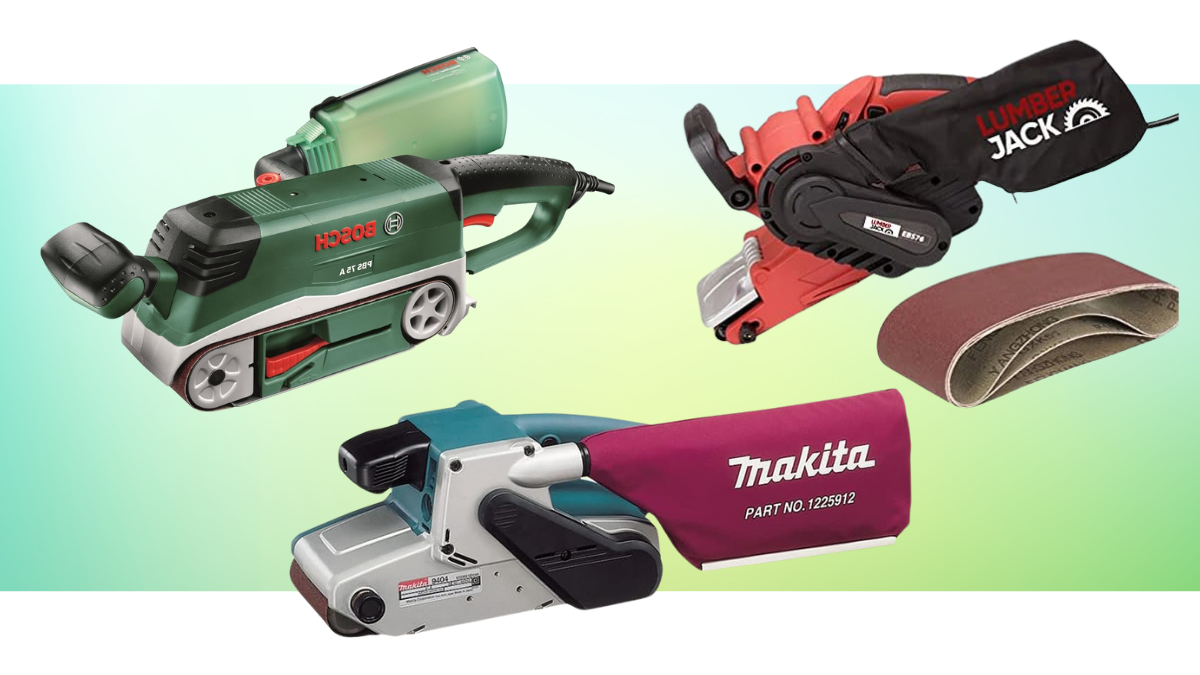
-
Best all-round belt sander - Bosch PBS 75 A Belt Sander
-
Best heavy duty belt sander - Makita 9404/2 Belt Sander
-
Best for beginners - Einhell TC-BC 8038 Belt Sander
-
Best budget belt sander - Jellas Electric Belt Sander
-
Best for smaller tasks - Black+Decker KA86 Belt Sander
-
Best with D-shaped handle - Lumberjack EBS76 3″ Belt Sander
-
Best cordless belt sander - Ryobi R18BS-0 One+ Cordless Belt Sander
Belt Sander Reviews
1. Bosch PBS 75 A Belt Sander [ SAVE 17% ]
Best all-round belt sander
- This reliable belt sander hits a happy medium of power, weight, and affordability.
- Compared with the lack of dust bag on the Jellas BS01, Bosch’s filtered dust box is brilliant. Even though this is a compact belt sander, it really works to catch most of the dust.
- The front handle has a positive soft grip that’s extremely comfortable.
- It’s incredibly easy to operate and change the belts. Ideal for a beginner.
- For a higher end Bosch “green” sander, it should really have variable speed control.
- The dust collection box is small. It gets filled up quickly and needs to be emptied too often.
- If, like me, you’re tall, you might feel like you need to lean over to use this sander. Compared to the Ryobi R18BS-0 the handles are harder to reach.
- Some users have complained that the clips used to attach the dust box are flimsy. If they break, the box won’t seal properly.
- Type
- Corded
- Power
- Mains - 710W
- Belt Size
- 75x533mm
- Max Belt Speed
- 350 mtrs per min
- Variable Speed
- No
- Power Cable
- 2.65m
- Weight
- 3.4kg
- No. of Belts
- 1
- Build Quality
- 4
- Performance
- 4
- Ease of Use
- 5
- Value For Money
- 5
German tool masters Bosch have been trusted by tradespeople and DIYers alike for over a century. I was excited to get hold of their PBS 75 A belt sander. It sits in their green range of quality tools for DIYers.
First off, this is a big belt sander. It’s nearly 55 cm long and the big front grip means you hold it low down to the workpiece. But the bulky stylings aren’t just for looks- you can flip the belt sander on its back and use it as a bench sander as well. The auto-align feature works well, so you don’t have to fiddle with adjusters either.
The 750-Watt motor should be powerful enough for tough jobs. It’s one of the best belt sanders for home projects. The only thing that really let me down is the lack of variable speed. It’s one of the more useful features found in belt sanders, and I wish that Bosch had added to this otherwise excellent machine.
Did you find this review helpful?
2. Makita 9404/2 Belt Sander[ SAVE 33% ]
Best heavy duty belt sander
- The build quality is what you’d expect from Makita. This reliable belt sander is built like a tank! You could take it on site and throw everything at it, and it’ll just keep on going.
- The ability to easily turn this into a bench sander is ideal. Most woodworkers will benefit from this flexibility. It’s a more versatile tool compared with the Ryobi R18BS-0.
- A flat top makes changing belts a breeze. You can also run it upside down for an instant bench sander. You can’t do that with the Black+Decker KA86.
- This sander has an extremely long power cable. Compared with the Bosch PBS 75A, at 5 metres it’s almost double.
- At nearly 5 kg, this is a heavy belt sander. If you’re not used to using one it might feel a bit unwieldy.
- It’s a shame that the power lock off button is only on one side. If you’re a left handed user, you might find it tricky to use.
- This isn’t a budget belt sander. Compared to the Jellas BS01 it’s quite expensive, but you still don’t get a case to store it in.
- Make sure you stock up on sanding belts, because this one only comes supplied with one.
- Type
- Corded
- Power
- Mains - 1,010W
- Belt Size
- 100x610mm
- Max Belt Speed
- 210-440 mtrs per min
- Variable Speed
- Yes
- Power Cable
- 5.0m
- Weight
- 4.7kg
- No. of Belts
- 1
- Build Quality
- 5
- Performance
- 5
- Ease of Use
- 5
- Value For Money
- 3
The best heavy duty belt sander for the UK market is the Makita 9404/2. It’s a superior stock removal tool that has variable speed control and is relatively quiet for such a powerful machine. As you’d expect from Makita, this is the best sander for floors and decking that I’ve come across.
The motor is tough enough to take on the biggest jobs. You can choose the belt speed from 210 m/min to 440 m/min. The unit itself has a low profile and is compact for such a powerful belt sander. But what I really like is how easy it is to handle. The grips are well-shaped and allow you to be precise whether you’re working on wood or metal.
Changing belts can be done in mere seconds. The dust extraction system is great and it’s easy to adjust the tracking if you need to. What makes this the best belt sander for woodworkers though are the threaded holes in the side of the metal housing. You can attach the belt sander to a jig and use it safely upside down, turning it into a quality bench sander.
Did you find this review helpful?
3. Einhell TC-BC 8038 Belt Sander [ SAVE 17% ]
Best for beginners
- I like the handle shape. Einhell have thought about how to make this user friendly belt sander comfortable without being bulky.
- The 800 Watt motor is small compared to the big 1,010 Watt one found on the Lumberjack EBS76. However, it still does a good solid job of sanding. It’s a good use of power.
- Most users have noted that this is a tough-built belt sander. It’s honest and reliable without being too heavy.
- Another belt sander that lacks a variable speed control. Compared to the versatile Jellas BS01 it’s a bit disappointing.
- Some users have noted the sander gets hot during use. Especially if you push it hard.
- The tracking knob on the side is tricky. You need to run the sander for a while after changing belts to get them centred.
- Type
- Corded
- Power
- Mains - 800W
- Belt Size
- 76x533mm
- Max Belt Speed
- 380 mtrs per min
- Variable Speed
- No
- Power Cable
- unknown
- Weight
- 3.4kg
- No. of Belts
- 1
- Build Quality
- 4
- Performance
- 4
- Ease of Use
- 4
- Value For Money
- 5
One of the more recognisable budget power tool brands on the UK market, Germany’s Einhell make honest tools for a fair price. I tried out their TC-BC 8038 belt sander and think it’s got to be one of the best belt sanders for beginners. I also found it to be a compact sander that can still remove a lot of material quickly.
The handles are well placed and are easy to hold on to with rubberised grips at the front and back. The belts are easy to change. The 800-Watt motor is just about strong enough to keep up with heavy sanding tasks on wood, plastic and even metal.
They throw in a dust collection bag, which is a nice touch. However, it’s an awkward shape to try and mount upside down. I wouldn’t try to use it as a bench sander any time soon. The one included belt is of decent quality though and means you can use it straight from the box.
Did you find this review helpful?
4. Jellas Electric Belt Sander
Best budget belt sander
- Jellas have included a whopping 12 sanding belts! Unless you’re doing seriously heavy work, they’ll last for ages.
- Compared to the Lumberjack EBS76, the range of belt speeds is impressive. 120 – 400 m/min gives you a lot of variation to play with.
- Using the most common size of sanding belt (75 x 533 mm) makes this easy to find consumables for.
- They’ve even thrown in a spare pair of brushes for the motor and a replacement drive belt. It good to see that Jellas think about their customers.
- You could balance it on its back, but it’s not designed to work like a bench sander.
- Even though the front of the belt is exposed, you can’t get into narrow spots. Compared to the Lumberjack EBS76 it’s limited.
- The build quality is good but compare it to the Makita 9404/2 and there’s many more plastic parts. I’m not sure this would last for long on site.
- Some users have had problems with the dust extraction system.
- Type
- Corded
- Power
- Mains - 1,000W
- Belt Size
- 75x533mm
- Max Belt Speed
- 120-400 mtrs per min
- Variable Speed
- Yes
- Power Cable
- 3.0m
- Weight
- 3.5kg
- No. of Belts
- 12
- Build Quality
- 4
- Performance
- 5
- Ease of Use
- 4
- Value For Money
- 4
This futuristic belt sander from tool pros Jellas is one of the best budget belt sanders around. The big 1,000-Watt motor means it can keep up with the big boys on my list. However, the six variable speeds set it apart from the competition.
It’s surprisingly comfortable to hold. The non-adjustable front handle is far enough forward to make it easy to use over long periods. Belt changing is easy, but you can’t easily mount it upside down to make a belt sander. It’s a shame because the trigger lock is easy to set and would make bench sanding a breeze.
For the money, this is one of the most user-friendly belt sanders you can get hold of. It’s well-balanced and doesn’t vibrate too much. The dust collection port is effective but doesn’t come with a dust bag. You’ll have to plug this machine directly into your shop vacuum.
Did you find this review helpful?
5. Black+Decker KA86 Belt Sander
Best for smaller tasks
- Compared with the expensive Makita 9404/2, this handy belt sander is a bargain! Don’t overspend unless you need professional-quality tools.
- More powerful than the Bosch PBS 75A, it’s also a lot less expensive. The 720 Watt motor narrowly beats the Bosch’s 710.
- The angled belt design gives you access to much tighter spots. Compared to the chunky Ryobi R18BS-0, there’s a lot more exposed belt to play with.
- Having an auto-tracking belt is handy for any DIYer to have. Less fiddling time means more working time.
- The ridiculous light weight of the sander is phenomenal. Weighing a mere 1.4 kg, you could use this above your head for hours. It’s incredibly easy to handle.
- There’s no sign of rubber overmoulding or vibration damping in the handle. Compared to the Einhell TC-BC’s positive grip shape, this is a bit disappointing.
- Having just 2.5 m of power cable to play with is not enough. In comparison with the mega 5 m cord on the Makita 9404/2, I know what I’d prefer to have.
- The belt length is a fair bit shorter compared to the Jellas BS01. It means the body is shorter, and will create more work for the user.
- Some users have questioned the build quality and reliability of this belt sander.
- Type
- Corded
- Power
- Mains - 720W
- Belt Size
- 75x457mm
- Max Belt Speed
- 206 mtrs per min
- Variable Speed
- No
- Power Cable
- 2.5m
- Weight
- 1.4kg
- No. of Belts
- 0
- Build Quality
- 4
- Performance
- 3
- Ease of Use
- 3
- Value For Money
- 3
One of the biggest names in DIY, Black+Decker have been making tools for more than 100 years. The KA86 belt sander isn’t the biggest or most powerful on my list. But, it’s great for precision jobs and is easily one of the best belt sanders for small tasks.
It’s less than half the weight of most of the belt sanders on our list. It’s ideal for when you need precision rather than raw power. Even so, the 720-Watt motor is powerful enough to put a dent into wood, plastic and even metal surfaces.
You don’t need to fiddle with the auto-tracking mechanism, which is a bonus. However, the body feels a bit plasticky and there’s no way to adjust the handles or the belt speed either. You get a sanding belt included though. The dust bag seems to do a good job of collecting the dust as well, so it’s an overall good purchase.
Did you find this review helpful?
6. Lumberjack EBS76 3″ Belt Sander
Best with D-shaped handle
- The fact you can lift the front flap is great. Compared to the Bosch PBS 75 A, the front end is incredibly narrow for a belt sander. It can fit into tiny spaces for such a big tool.
- I really like the “D” shaped front handle. It’s comfortable in the hand and feels well balanced.
- The top of the sander has a flat surface. Mounting it upside down is possible if a little bit unstable.
- Lumberjack have included three sanding belts. It should get you started straight from the box.
- The maximum belt speed is a bit low. Maxing out at 380 m/min isn’t too impressive. It doesn’t compare to the Makita 9404/2 that whips along 440 m/min.
- Some users have complained that the dust bag doesn’t do a great job.
- Weighing in at 3.7 kg, it’s not the lightest sander compared with the competition.
- It’s also a rather loud sander. Make sure you’re wearing hearing protection.
- Type
- Corded
- Power
- Mains - 1,010W
- Belt Size
- 76x533mm
- Max Belt Speed
- 120-380 mtrs per min
- Variable Speed
- Yes
- Power Cable
- unknown
- Weight
- 3.3kg
- No. of Belts
- 3
- Build Quality
- 4
- Performance
- 5
- Ease of Use
- 4
- Value For Money
- 4
Wolverhampton based Lumberjack Tools have three decades’ experience making a whole range of quality woodworking tools. It’s probably why the EBS76 belt sander looks like a chainsaw without the chain on.
This powerful belt sander comes with a large 1010-Watt motor and puts out a massive up to 380m/min belt speed. It’s more than enough to make short work of wood, metal and plastic surfaces using the three included sanding belts.
The chainsaw-type front handle is adjustable. It makes it easy to handle when you need that extra bit of precision. The front flap can lift up if you need to get into a tight spot as well. And if you fold the front handle down, you could probably run it upside down without too much trouble.
Did you find this review helpful?
7. Ryobi R18BS-0 One+ Cordless Belt Sander[ SAVE 9% ]
Best cordless belt sander
- If you’ve got a Ryobi 18V battery for your drill, you’ve got an 18V battery for this sander.
- The brushless motor will get the most out of your batteries.
- Even compared to the Makita 9404/2’s 5 metre cable, cordless tools are winners.
- This is a relatively lightweight sander. Even with a big battery installed it’s just over 3 kg.
- Having an adjustable front handle is a nice touch. It should keep things comfortable over time.
- I hope you have a lot of batteries to spare! This sander chews through even high Ah ones in no time at all. It’s a power hungry beast.
- There’s no easy way to mount this portable belt sander upside down. This means you can’t turn it into a bench sander on the fly.
- The tracking adjustment is too sensitive. It will take a while to dial in the correct tracking when you install a new belt.
- Some users have found problems with the front handle. It won’t stay in one position, even when you tighten up the holding screw.
- Type
- Cordless
- Power
- Battery - 18V
- Belt Size
- 76x457mm
- Max Belt Speed
- 250 mtrs per min
- Variable Speed
- No
- Power Cable
- n/a
- Weight
- 2.7kg (excl battery)
- No. of Belts
- 3
- Build Quality
- 4
- Performance
- 3
- Ease of Use
- 4
- Value For Money
- 3
I’m a big fan of Japanese tool brand Ryobi. Especially their ONE+ range of cordless power tools that all share the same battery type. The R18BS-0 belt sander is the best cordless belt sander that I’ve tried out. With a brushless motor and a belt speed of 250m/min it offers all the power you could ask for, and all without annoying power cords.
It’s a chunky but compact belt sander that makes use of a clever adjustable front handle to save on overall body size. It means you can play around with the settings to make it comfortable no matter how long or short your arms are. The drawback of this design is you can’t easily mount it upside down as a bench sander.
Hands down the best thing about this belt sander is that it’s cordless. Even the longest cables get in the way when you’re sanding long pieces of wood, metal, or plastic. Going cordless makes this the best cordless belt sander you can get. The only gripes I have are a lack of variable speed and a fiddly tracking wheel.
Did you find this review helpful?
Compare Product Features
Use the dropdown to sort the table by the feature you want to see.
Bosch PBS 75 A Belt Sander

- 4.5
- Corded
- Mains - 710W
- 75x533mm
- 350 mtrs per min
- No
- 2.65m
- 3.4kg
- 1
Makita 9404/2 Belt Sander
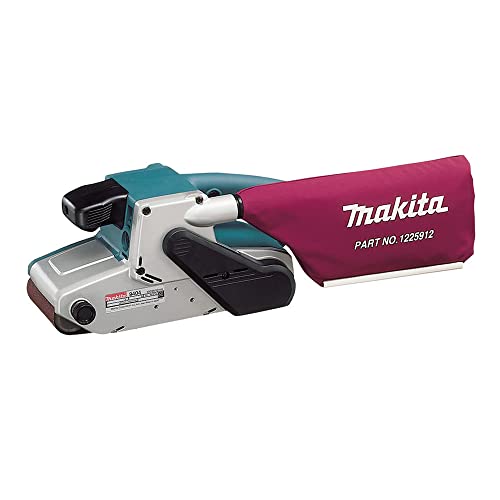
- 4.5
- Corded
- Mains - 1,010W
- 100x610mm
- 210-440 mtrs per min
- Yes
- 5.0m
- 4.7kg
- 1
Einhell TC-BC 8038 Belt Sander
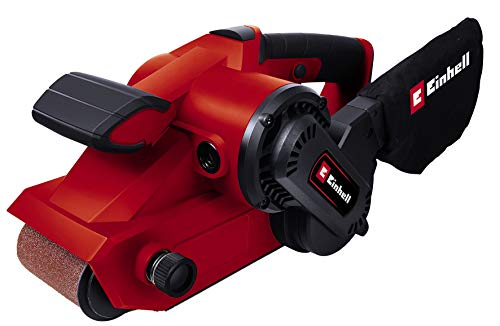
- 4.3
- Corded
- Mains - 800W
- 76x533mm
- 380 mtrs per min
- No
- unknown
- 3.4kg
- 1
Jellas Electric Belt Sander
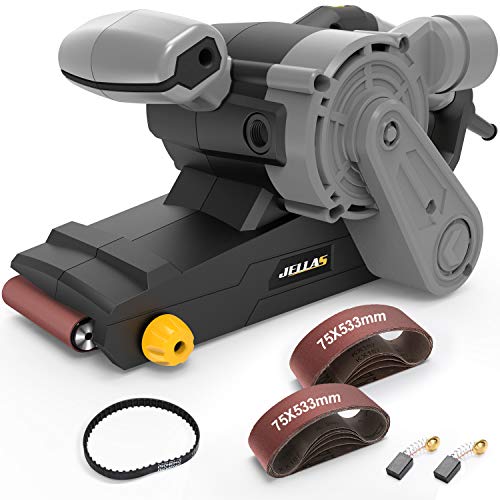
- 4.3
- Corded
- Mains - 1,000W
- 75x533mm
- 120-400 mtrs per min
- Yes
- 3.0m
- 3.5kg
- 12
Black+Decker KA86 Belt Sander
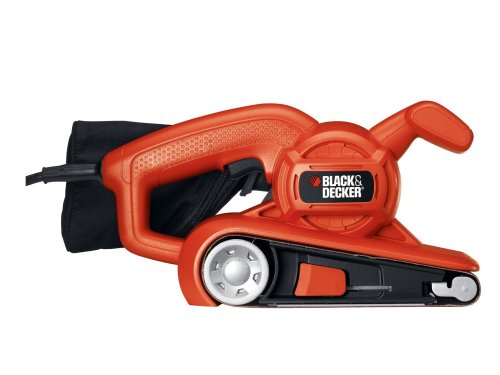
- 3.3
- Corded
- Mains - 720W
- 75x457mm
- 206 mtrs per min
- No
- 2.5m
- 1.4kg
- 0
Lumberjack EBS76 3″ Belt Sander
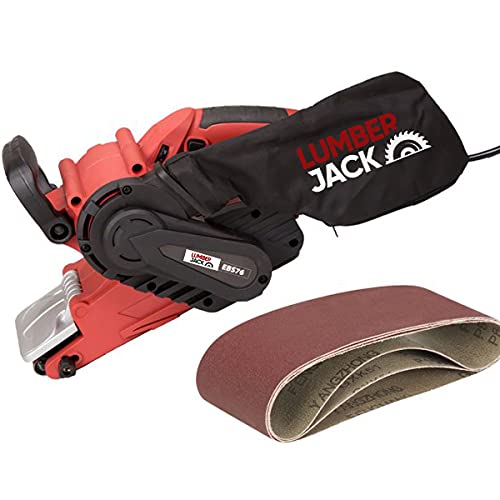
- 4.3
- Corded
- Mains - 1,010W
- 76x533mm
- 120-380 mtrs per min
- Yes
- unknown
- 3.3kg
- 3
Ryobi R18BS-0 One+ Cordless Belt Sander
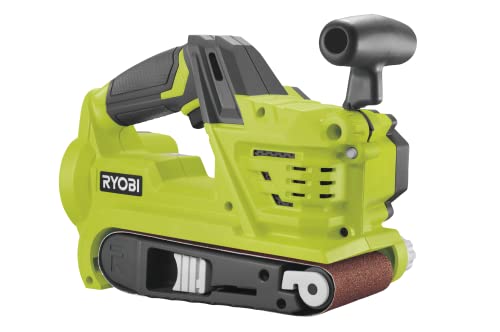
- 3.5
- Cordless
- Battery - 18V
- 76x457mm
- 250 mtrs per min
- No
- n/a
- 2.7kg (excl battery)
- 3
How to Choose The Best Belt Sander
When you need to remove a lot of material from something like floorboards or decking, you’d be mad to try and attempt it with sanding blocks and elbow grease. Electric belt sanders are ideal machines when you need to prepare surfaces quickly and easily.
Corded and Cordless Belt Sanders
There’s nothing more annoying than running out of cable when you’re working on a big job- even though the best belt sanders come with up to five-metre-long cables, they can still be too short. As battery-powered tools have become more common, belt sanders haven’t been left behind. You can get all the power of a corded sander without being held back by cables. But belt sanders are incredibly power-hungry and will only last a matter of minutes before they need recharging.
Different Belts for Different Jobs
One of my favourite things about belt sanders is that they’re incredibly versatile tools. You can swap out a sanding belt in seconds and tackle different materials and use different grits depending on the job. When it comes to grits, the smaller the number, the coarser the sanding belt. 40 grit is for removing a lot of material and 200 grit, for example, is for much finer work.
Varying the Speed
I’m a firm believer in variable-speed belt sanders. You can get the job done with a single-speed unit, but I think the best belt sanders come with variable-speed controllers. You have more control over how much material you’re removing and the heat you generate while working.
Belt Sander FAQs
You should check the instructions that come with your belt sander, but most tools work in a similar way. On the side of the belt sander will be an arm that you can use to remove the tension from the sanding belt. Once the belt is loose, you can pull it off. When replacing a belt, look for the directional arrows on the belt and sander, and always make sure the arrows line up.
A sanding belt is made by glueing a strip of abrasive material into a loop- the leading edge needs to be facing away from the direction of travel or it can work loose. A loose sanding belt can come undone suddenly and whip the user, causing injury.
If your sanding belt is taking a long time to remove material and is producing excessive heat, it’s time to replace it. You can test how much grit is left by comparing an old belt to a new one.
Belt sanders can be noisy, so you should always wear ear protection. Even if your belt sander comes with dust extraction, you should wear a suitable mask to avoid breathing in fine particles and eyewear in case of flying debris.

Share